ECO mode Hyundai Ioniq Electric 2017 Owner's Manual
[x] Cancel search | Manufacturer: HYUNDAI, Model Year: 2017, Model line: Ioniq Electric, Model: Hyundai Ioniq Electric 2017Pages: 582, PDF Size: 37.73 MB
Page 8 of 582
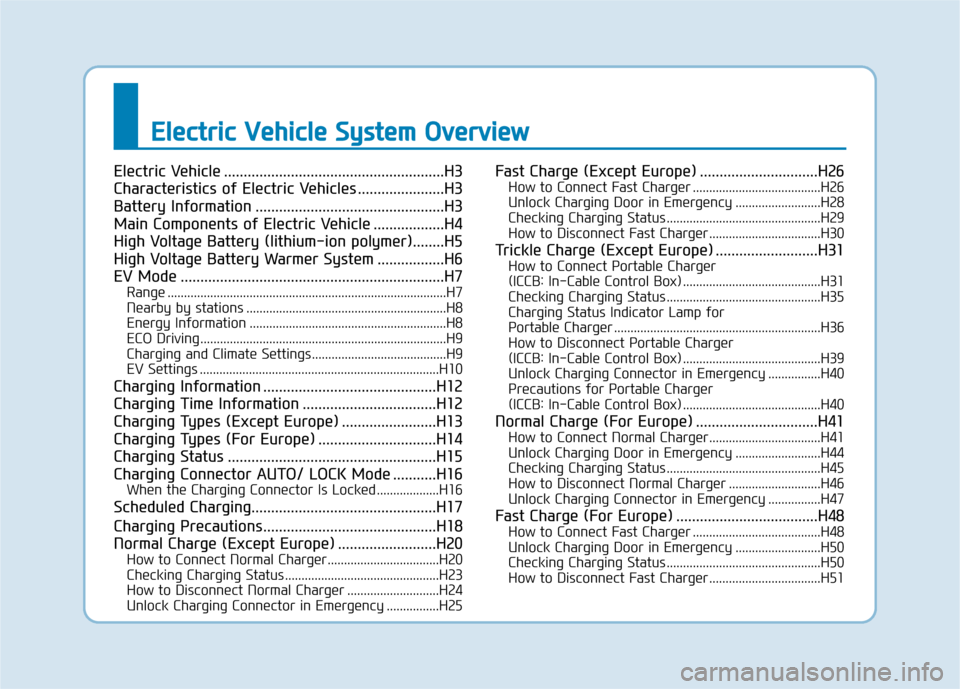
EEllee ccttrr iicc VV eehh iicc llee SS yyssttee mm OO vvee rrvv iiee ww
Electric Vehicle ........................................................H3
Characteristics of Electric Vehicles ......................H3
Battery Information ................................................H3
Main Components of Electric Vehicle ..................H4
High Voltage Battery (lithium-ion polymer)........H5
High Voltage Battery Warmer System .................H6
EV Mode ...................................................................H7
Range .....................................................................................H7
Nearby by stations .............................................................H8
Energy Information ............................................................H8
ECO Driving ...........................................................................H9
Charging and Climate Settings.........................................H9
EV Settings .........................................................................H10
Charging Information ............................................H12
Charging Time Information ..................................H12
Charging Types (Except Europe) ........................H13
Charging Types (For Europe) ..............................H14
Charging Status .....................................................H15
Charging Connector AUTO/ LOCK Mode ...........H16 When the Charging Connector Is Locked ...................H16
Scheduled Charging...............................................H17
Charging Precautions............................................H18
Normal Charge (Except Europe) .........................H20 How to Connect Normal Charger..................................H20
Checking Charging Status ...............................................H23
How to Disconnect Normal Charger ............................H24
Unlock Charging Connector in Emergency ................H25 Fast Charge (Except Europe) ..............................H26
How to Connect Fast Charger .......................................H26
Unlock Charging Door in Emergency ..........................H28
Checking Charging Status ...............................................H29
How to Disconnect Fast Charger ..................................H30
Trickle Charge (Except Europe) ..........................H31 How to Connect Portable Charger
(ICCB: In-Cable Control Box) ..........................................H31Checking Charging Status ...............................................H35
Charging Status Indicator Lamp for
Portable Charger ...............................................................H36
How to Disconnect Portable Charger
(ICCB: In-Cable Control Box) ..........................................H39 Unlock Charging Connector in Emergency ................H40
Precautions for Portable Charger
(ICCB: In-Cable Control Box) ..........................................H40
Normal Charge (For Europe) ...............................H41 How to Connect Normal Charger..................................H41
Unlock Charging Door in Emergency ..........................H44
Checking Charging Status ...............................................H45
How to Disconnect Normal Charger ............................H46
Unlock Charging Connector in Emergency ................H47
Fast Charge (For Europe) ....................................H48 How to Connect Fast Charger .......................................H48
Unlock Charging Door in Emergency ..........................H50
Checking Charging Status ...............................................H50
How to Disconnect Fast Charger ..................................H51
Page 9 of 582
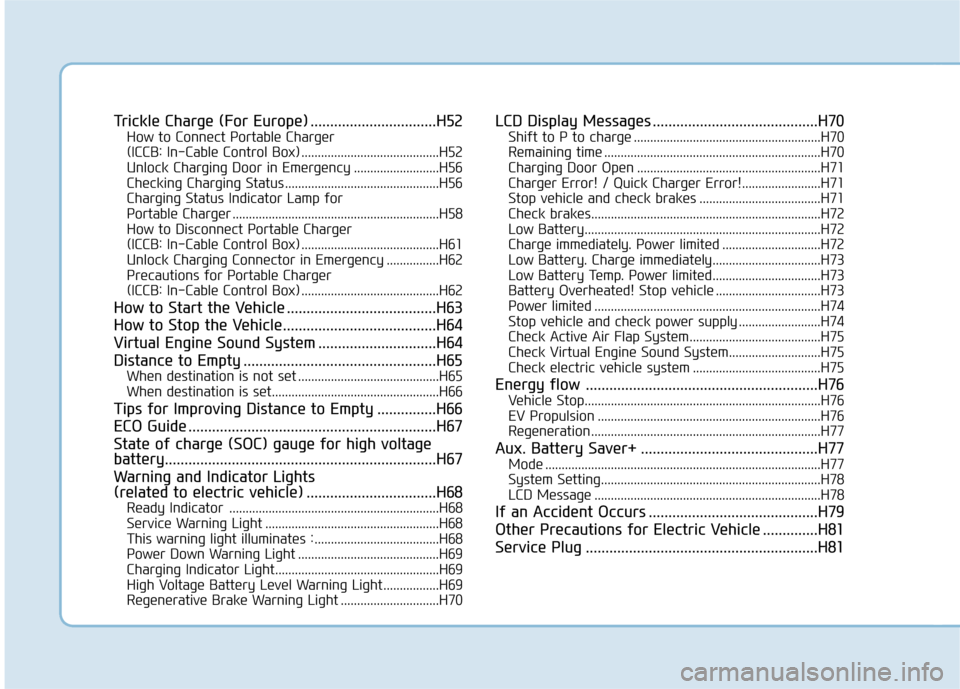
Trickle Charge (For Europe) ................................H52How to Connect Portable Charger
(ICCB: In-Cable Control Box) ..........................................H52Unlock Charging Door in Emergency ..........................H56
Checking Charging Status ...............................................H56
Charging Status Indicator Lamp for
Portable Charger ...............................................................H58
How to Disconnect Portable Charger
(ICCB: In-Cable Control Box) ..........................................H61 Unlock Charging Connector in Emergency ................H62
Precautions for Portable Charger
(ICCB: In-Cable Control Box) ..........................................H62
How to Start the Vehicle ......................................H63
How to Stop the Vehicle.......................................H64
Virtual Engine Sound System ..............................H64
Distance to Empty .................................................H65 When destination is not set ...........................................H65
When destination is set...................................................H66
Tips for Improving Distance to Empty ...............H66
ECO Guide ...............................................................H67
State of charge (SOC) gauge for high voltage
battery.....................................................................H67
Warning and Indicator Lights
(related to electric vehicle) .................................H68 Ready Indicator ................................................................H68
Service Warning Light .....................................................H68
This warning light illuminates : ......................................H68
Power Down Warning Light ...........................................H69
Charging Indicator Light..................................................H69
High Voltage Battery Level Warning Light .................H69
Regenerative Brake Warning Light ..............................H70 LCD Display Messages ..........................................H70
Shift to P to charge .........................................................H70
Remaining time ..................................................................H70
Charging Door Open ........................................................H71
Charger Error! / Quick Charger Error!........................H71
Stop vehicle and check brakes .....................................H71
Check brakes......................................................................H72
Low Battery........................................................................H72
Charge immediately. Power limited ..............................H72
Low Battery. Charge immediately.................................H73
Low Battery Temp. Power limited.................................H73
Battery Overheated! Stop vehicle ................................H73
Power limited .....................................................................H74
Stop vehicle and check power supply .........................H74
Check Active Air Flap System........................................H75
Check Virtual Engine Sound System............................H75
Check electric vehicle system .......................................H75
Energy flow ...........................................................H76 Vehicle Stop........................................................................H76
EV Propulsion ....................................................................H76
Regeneration ......................................................................H77
Aux. Battery Saver+ .............................................H77 Mode ....................................................................................H77
System Setting...................................................................H78
LCD Message .....................................................................H78
If an Accident Occurs ...........................................H79
Other Precautions for Electric Vehicle ..............H81
Service Plug ...........................................................H81
Page 10 of 582
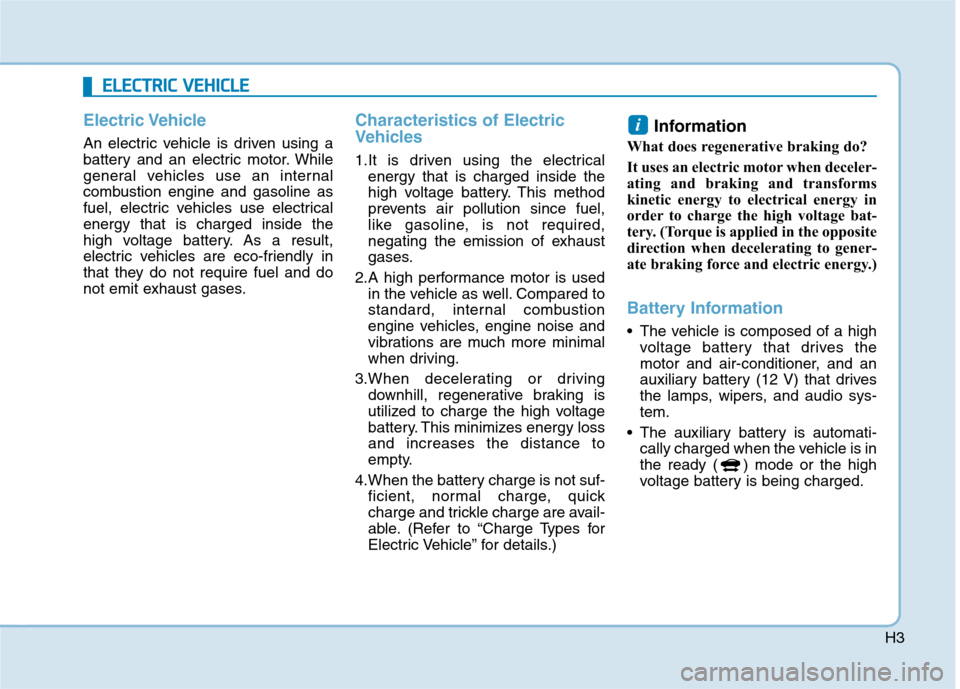
H3
Electric Vehicle
An electric vehicle is driven using a
battery and an electric motor. While
general vehicles use an internal
combustion engine and gasoline as
fuel, electric vehicles use electricalenergy that is charged inside the
high voltage battery. As a result,
electric vehicles are eco-friendly in
that they do not require fuel and do
not emit exhaust gases.
Characteristics of Electric
Vehicles
1.It is driven using the electricalenergy that is charged inside the
high voltage battery. This method
prevents air pollution since fuel,
like gasoline, is not required,
negating the emission of exhaust
gases.
2.A high performance motor is used in the vehicle as well. Compared to
standard, internal combustion
engine vehicles, engine noise and
vibrations are much more minimal
when driving.
3.When decelerating or driving downhill, regenerative braking is
utilized to charge the high voltage
battery. This minimizes energy lossand increases the distance to
empty.
4.When the battery charge is not suf- ficient, normal charge, quick
charge and trickle charge are avail-
able. (Refer to “Charge Types for
Electric Vehicle” for details.) Information
What does regenerative braking do?
It uses an electric motor when deceler-
ating and braking and transforms
kinetic energy to electrical energy in
order to charge the high voltage bat-
tery. (Torque is applied in the opposite
direction when decelerating to gener-
ate braking force and electric energy.)
Battery Information
The vehicle is composed of a high voltage battery that drives the
motor and air-conditioner, and an
auxiliary battery (12 V) that drives
the lamps, wipers, and audio sys-tem.
The auxiliary battery is automati- cally charged when the vehicle is in
the ready ( ) mode or the high
voltage battery is being charged.
i
EELLEE CCTT RR IICC VV EEHH IICC LLEE
Page 12 of 582
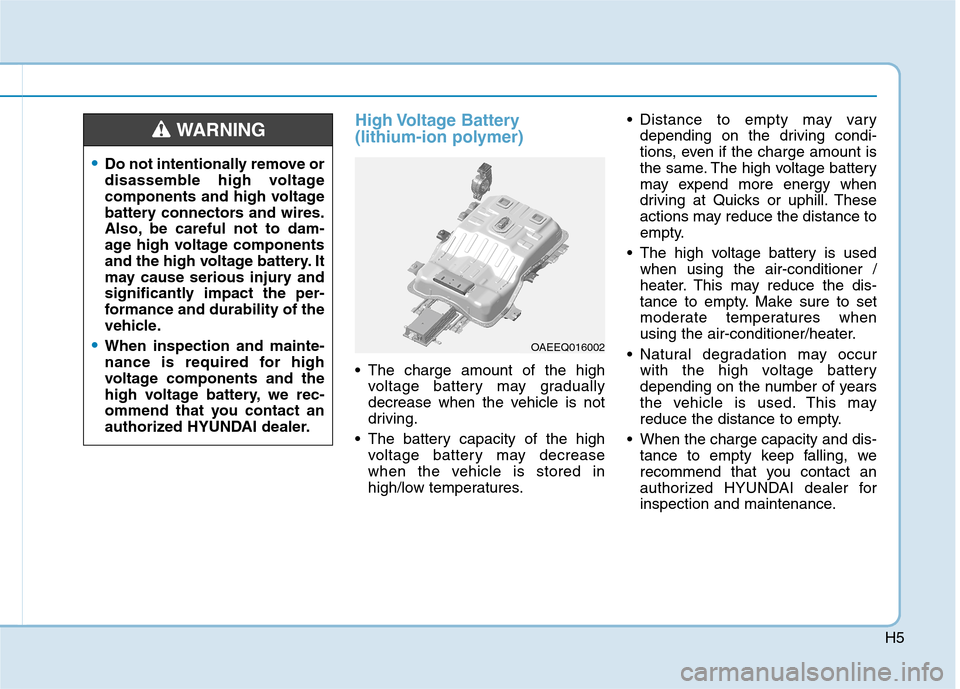
H5
High Voltage Battery
(lithium-ion polymer)
The charge amount of the highvoltage battery may gradually
decrease when the vehicle is not
driving.
The battery capacity of the high voltage battery may decrease
when the vehicle is stored in
high/low temperatures. Distance to empty may vary
depending on the driving condi-
tions, even if the charge amount is
the same. The high voltage battery
may expend more energy when
driving at Quicks or uphill. These
actions may reduce the distance to
empty.
The high voltage battery is used when using the air-conditioner /
heater. This may reduce the dis-
tance to empty. Make sure to set
moderate temperatures when
using the air-conditioner/heater.
Natural degradation may occur with the high voltage battery
depending on the number of years
the vehicle is used. This may
reduce the distance to empty.
When the charge capacity and dis- tance to empty keep falling, we
recommend that you contact an
authorized HYUNDAI dealer for
inspection and maintenance.
•Do not intentionally remove or
disassemble high voltage
components and high voltage
battery connectors and wires.
Also, be careful not to dam-
age high voltage components
and the high voltage battery. It
may cause serious injury and
significantly impact the per-
formance and durability of the
vehicle.
When inspection and mainte-
nance is required for high
voltage components and the
high voltage battery, we rec-
ommend that you contact an
authorized HYUNDAI dealer.
WARNING
OAEEQ016002
Page 14 of 582
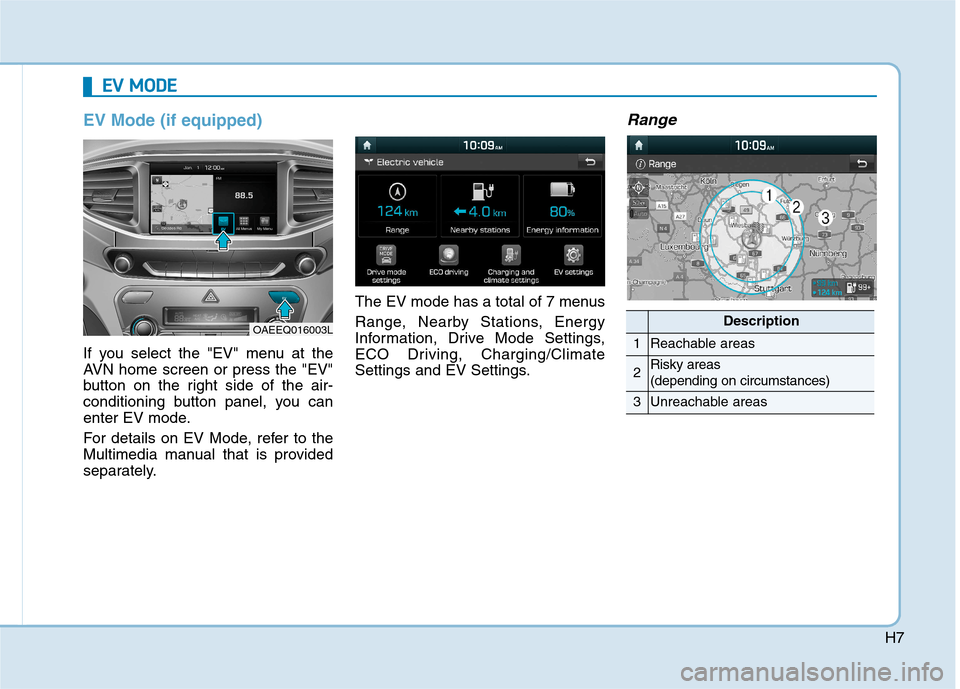
H7
EV Mode (if equipped)
If you select the "EV" menu at the
AVN home screen or press the "EV"
button on the right side of the air-
conditioning button panel, you can
enter EV mode.
For details on EV Mode, refer to the
Multimedia manual that is provided
separately.The EV mode has a total of 7 menus
Range, Nearby Stations, Energy
Information, Drive Mode Settings,
ECO Driving, Charging/Climate
Settings and EV Settings.
Range
EE
VV MM OODDEE
OAEEQ016003LDescription
1Reachable areas
2Risky areas (depending on circumstances)
3Unreachable areas
Page 40 of 582
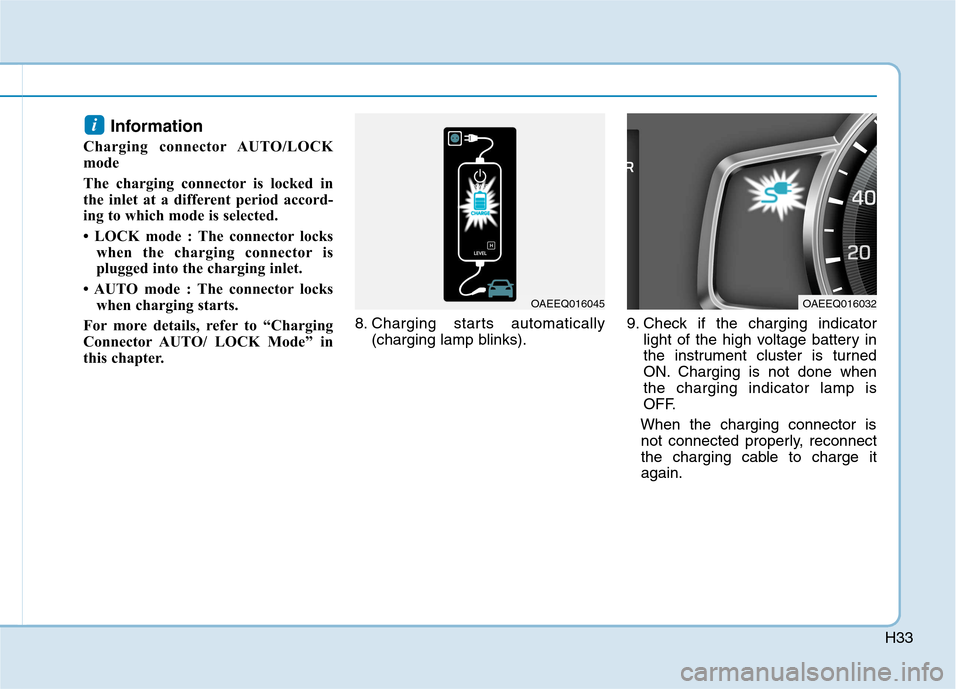
H33
Information
Charging connector AUTO/LOCK
mode
The charging connector is locked in
the inlet at a different period accord-
ing to which mode is selected.
LOCK mode : The connector locks when the charging connector is
plugged into the charging inlet.
AUTO mode : The connector locks when charging starts.
For more details, refer to “Charging
Connector AUTO/ LOCK Mode” in
this chapter. 8. Charging starts automatically
(charging lamp blinks). 9. Check if the charging indicator
light of the high voltage battery in
the instrument cluster is turned
ON. Charging is not done whenthe charging indicator lamp is
OFF.
When the charging connector is not connected properly, reconnect
the charging cable to charge itagain.i
OAEEQ016045OAEEQ016032
Page 45 of 582
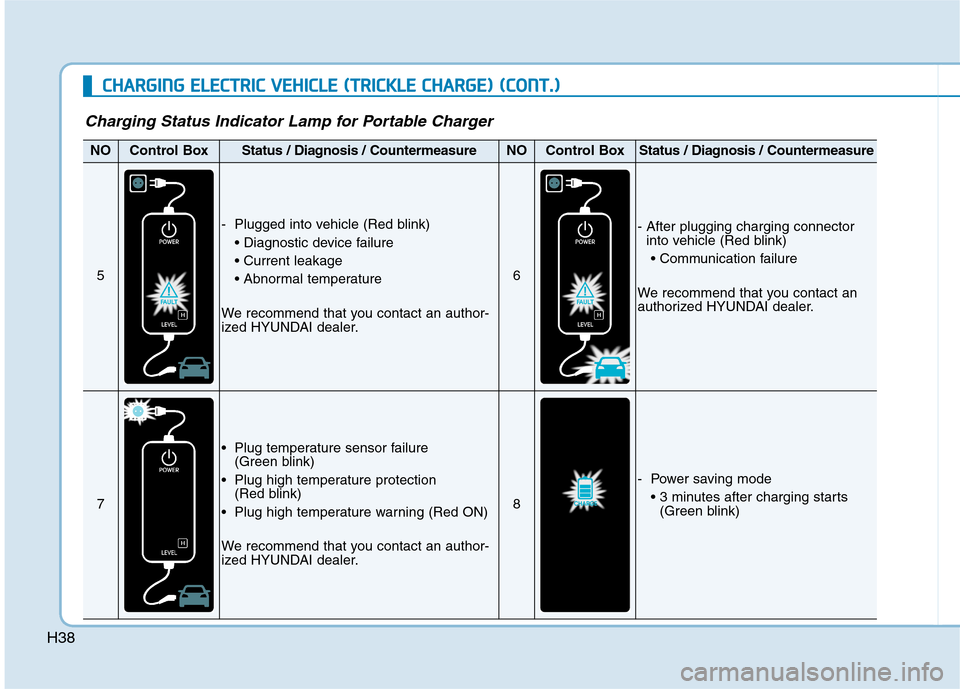
H38
CCHH AARRGG IINN GG EE LLEE CCTT RR IICC VV EEHH IICC LLEE (( TT RR IICC KK LLEE CC HH AARRGG EE)) (( CC OO NNTT..))
NOControl BoxStatus / Diagnosis / CountermeasureNOControl BoxStatus / Diagnosis / Countermeasure
5
- Plugged into vehicle (Red blink)
We recommend that you contact an author-
ized HYUNDAI dealer.
6
- After plugging charging connector into vehicle (Red blink)
We recommend that you contact an
authorized HYUNDAI dealer.
7
Plug temperature sensor failure (Green blink)
Plug high temperature protection (Red blink)
Plug high temperature warning (Red ON)
We recommend that you contact an author-
ized HYUNDAI dealer.
8
- Power saving mode (Green blink)
Charging Status Indicator Lamp for Portable Charger
Page 67 of 582
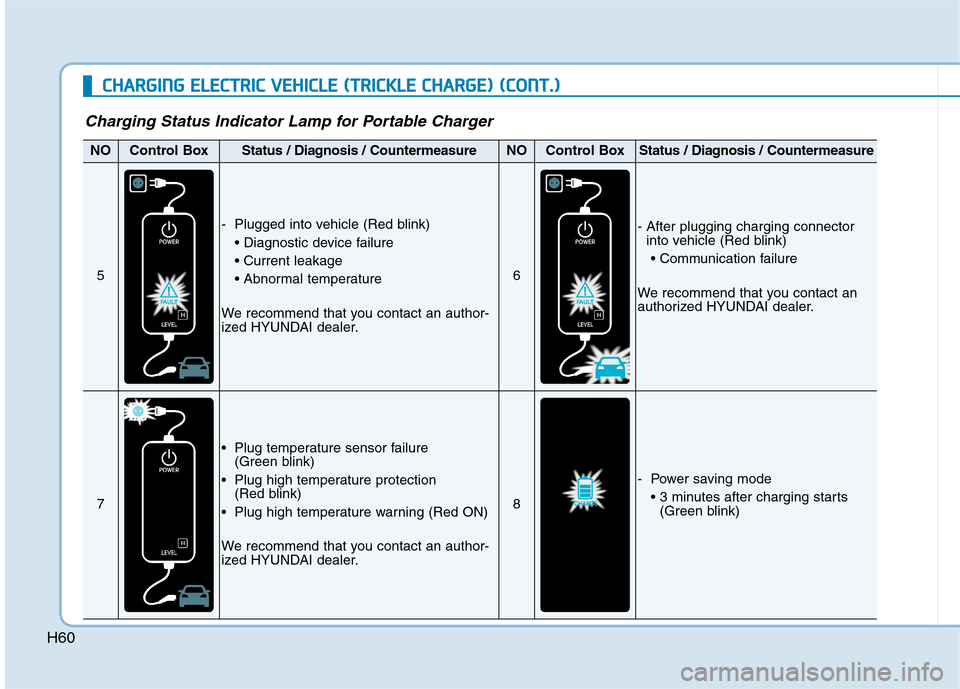
H60
CCHH AARRGG IINN GG EE LLEE CCTT RR IICC VV EEHH IICC LLEE (( TT RR IICC KK LLEE CC HH AARRGG EE)) (( CC OO NNTT..))
NOControl BoxStatus / Diagnosis / CountermeasureNOControl BoxStatus / Diagnosis / Countermeasure
5
- Plugged into vehicle (Red blink)
We recommend that you contact an author-
ized HYUNDAI dealer.
6
- After plugging charging connector into vehicle (Red blink)
We recommend that you contact an
authorized HYUNDAI dealer.
7
Plug temperature sensor failure (Green blink)
Plug high temperature protection (Red blink)
Plug high temperature warning (Red ON)
We recommend that you contact an author-
ized HYUNDAI dealer.
8
- Power saving mode (Green blink)
Charging Status Indicator Lamp for Portable Charger
Page 72 of 582
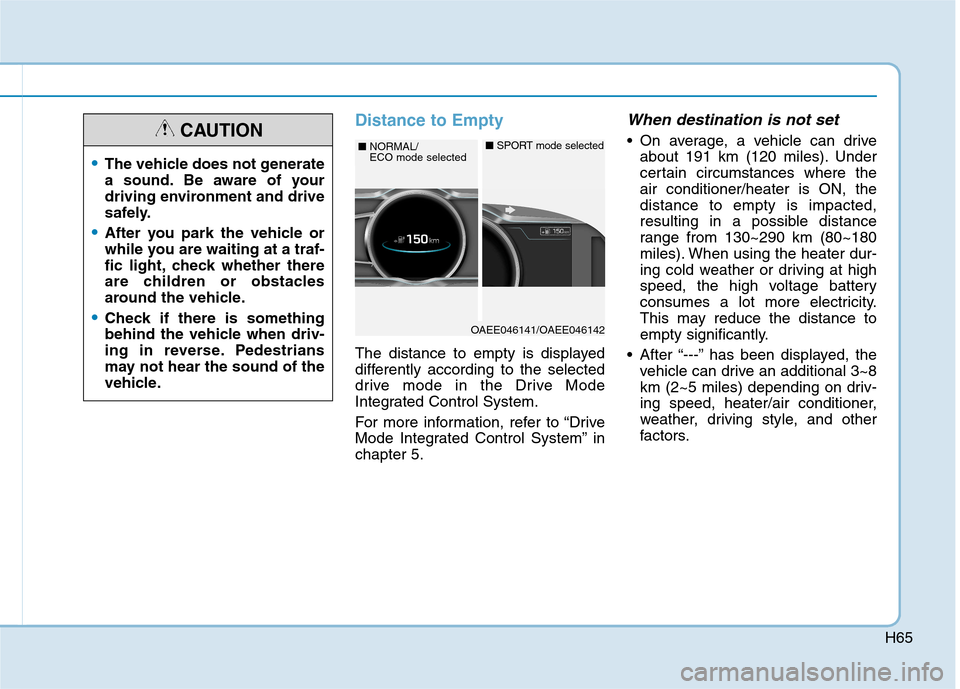
H65
Distance to Empty
The distance to empty is displayed
differently according to the selected
drive mode in the Drive Mode
Integrated Control System.
For more information, refer to “Drive
Mode Integrated Control System” inchapter 5.
When destination is not set
On average, a vehicle can driveabout 191 km (120 miles). Under
certain circumstances where theair conditioner/heater is ON, thedistance to empty is impacted,
resulting in a possible distance
range from 130~290 km (80~180
miles). When using the heater dur-
ing cold weather or driving at high
speed, the high voltage battery
consumes a lot more electricity.
This may reduce the distance to
empty significantly.
After “---” has been displayed, the vehicle can drive an additional 3~8
km (2~5 miles) depending on driv-
ing speed, heater/air conditioner,
weather, driving style, and other
factors.
OAEE046141/OAEE046142
■NORMAL/ ECO mode selected■ SPORT mode selected
The vehicle does not generate
a sound. Be aware of your
driving environment and drive
safely.
After you park the vehicle or
while you are waiting at a traf-
fic light, check whether there
are children or obstacles
around the vehicle.
Check if there is something
behind the vehicle when driv-
ing in reverse. Pedestrians
may not hear the sound of the
vehicle.
CAUTION
Page 73 of 582
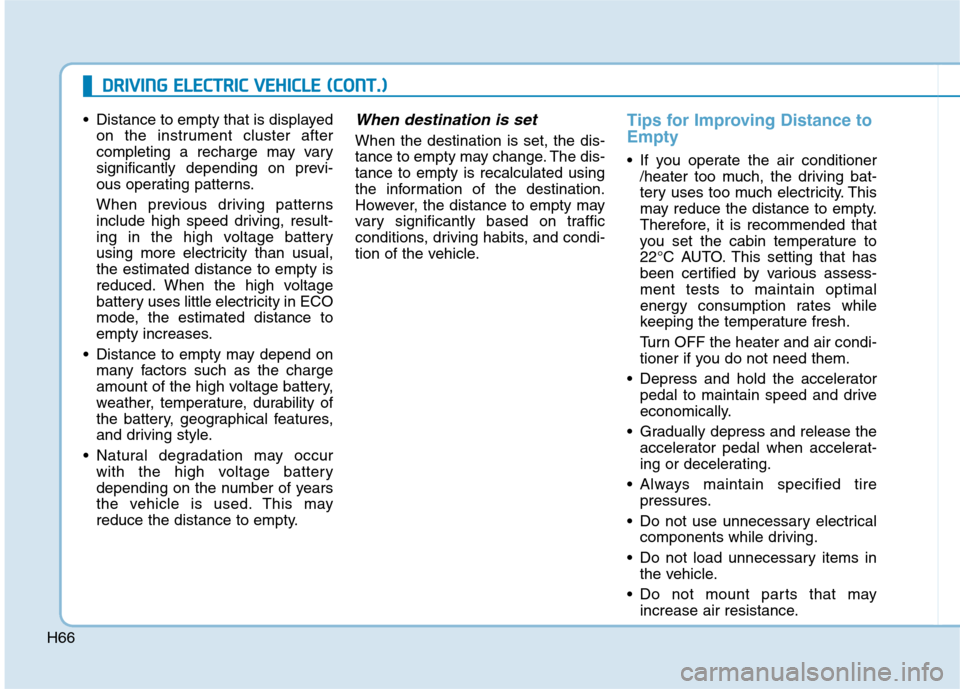
H66
DDRRIIVV IINN GG EE LLEE CCTT RR IICC VV EEHH IICC LLEE (( CC OO NNTT..))
Distance to empty that is displayed
on the instrument cluster after
completing a recharge may vary
significantly depending on previ-
ous operating patterns.
When previous driving patterns
include high speed driving, result-
ing in the high voltage battery
using more electricity than usual,the estimated distance to empty is
reduced. When the high voltage
battery uses little electricity in ECO
mode, the estimated distance to
empty increases.
Distance to empty may depend on many factors such as the charge
amount of the high voltage battery,
weather, temperature, durability of
the battery, geographical features,
and driving style.
Natural degradation may occur with the high voltage battery
depending on the number of years
the vehicle is used. This may
reduce the distance to empty.When destination is set
When the destination is set, the dis-
tance to empty may change. The dis-tance to empty is recalculated using
the information of the destination.
However, the distance to empty may
vary significantly based on traffic
conditions, driving habits, and condi-
tion of the vehicle.
Tips for Improving Distance to Empty
If you operate the air conditioner/heater too much, the driving bat-
tery uses too much electricity. This
may reduce the distance to empty.
Therefore, it is recommended that
you set the cabin temperature to
22°C AUTO. This setting that has
been certified by various assess-ment tests to maintain optimal
energy consumption rates while
keeping the temperature fresh.
Turn OFF the heater and air condi-
tioner if you do not need them.
Depress and hold the accelerator pedal to maintain speed and drive
economically.
Gradually depress and release the accelerator pedal when accelerat-
ing or decelerating.
Always maintain specified tire pressures.
Do not use unnecessary electrical components while driving.
Do not load unnecessary items in the vehicle.
Do not mount parts that may increase air resistance.